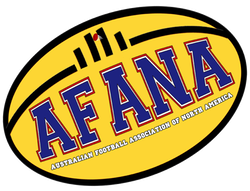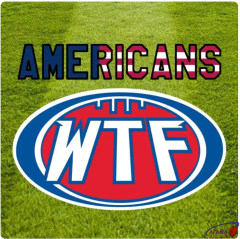by Lisa Albergo reporting for AFANA from Chicago
From 1898-1911, there was a magazine devoted to Australian football, the Victorian Football Follower. In 1912, the same year numbers were first worn by players, the Football Record made its debut. Its motto was "Fair play is bonnie play' and it ran to about 30 pages in a pocket size format, a far cry from today's lavish tomes which run over 200 pages.
To celebrate 100 years of its existence, the AFL Record and its publisher, the Slattery Media Group, decided to release a special collector's edition of every Grand Final Record from 1912-2011. Because the page size of the Records has changed over the years, these have been reproduced in a box set of 11 volumes. As a bonus, the first volume, which covers 1912-1930, also includes the very first Record which was released on April 27, 1912.
It is interesting to skim the various volumes to see the evolution of match coverage, feature stories and the magazine itself. In the early days, contributors wrote under pseudonyms such as Chatter and there were no editorials. The few photographs that are included are a bit grainy and advertisements are illustrated. Like today's editions, it does feature a page listing all the scores from the season just completed. Come Grand Final day, it was still only 30 pages long, with a half-page preview. The rest of this edition featured news snippets, all the season's scores, previous Grand Final winners, and very short reports on the finals series. It is also interesting to see how the language has changed over the years. In those early days, a team might be described as attacking the match with vigor and players putting on a manly display. Today, it would be the intensity and pressure, with players attacking man and ball with aggression, fierce tackling and shutting down the opposition.
Changes were slow over the first 50 years. It wasn't until 1963 that some color was added for advertisements and as a background on some of the pages. 1966 saw the first full color cover. 1970 was the first year to feature player profiles but it still ran just 30 pages. It was not until the 1980s that the Grand Final Record ran to 100 pages. From here the changes are more rapid as the game went national. Although the VFL became the AFL in 1990 to reflect the nationalization of the game, the Football Record remained through 1998. It finally became the AFL Record in 1999.
Even with this special edition, original copies of Grand Final Records will continue to be collectables. Rick Milne is a collector and dealer of memorabilia. He has a column in the current AFL Records where fans can inquire about items they have or have found. According to Milne, an original copy of the very first Record could sell for up to $10,000. Not bad for something that first sold for just a penny. Even the miniature replica which was inserted in a 1996 edition to celebrate the game's centennial can fetch about $10. A copy of the 1970 Record in excellent condition, which cost just 20 cents at the time, is now worth $150.
These replicas certainly won't diminish the value of original Records. However, for those die-hard fans who don't have the opportunity to rummage through shops or garage sales, they are a wonderful walk through history, with the more recent Records a great trip down memory lane. Although a bit pricy at $450 Australian plus shipping, it is well worth it for the dedicated fans of the greatest game on the planet. .
Key Facts:
1912: First edition of The Record is published “under patronage of the Victorian Football League”.
1914-16: Production continued during the war, despite a scarcity of materials and only four teams in the competition.
1961: An image from the previous round of matches replaces a line drawing on the cover. For the first time the cover also includes the line “Official Organ of the Victorian Football League”.
1963: The Finals series Records were produced in color for the first time.
1966: The Grand Final edition was the first Record to be produced as an A4 publication.
1968: All Finals Records are produced as A4 publications.
1978: All editions during the season printed in color for the first time.
1994: The Record is produced with new “desktop” technology.
1999: The Football Record is changed to the AFL Record. A record sale - by percentage against attendance - of 48.3 per cent is achieved at the final match at Victoria Park between Collingwood and the Brisbane Lions.
2012: The AFL Record is available online as an iPad edition.
Source: AFL Record, author notes
Article last changed on Tuesday, January 27, 2015 - 12:17 AM EST






